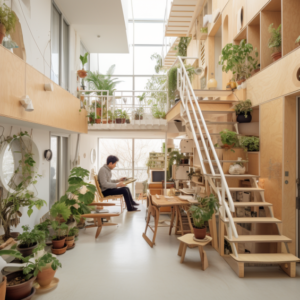Nomadic living, characterized by mobility and adaptability, intersects with the principles of minimalism, emphasizing simplicity, functionality, and a deliberate reduction of excess. This article delves into the concept of “Mobile Minimalism,” examining how minimalist design principles are applied to nomadic homes. From streamlined aesthetics to efficient use of space, this exploration highlights the synergy between the nomadic lifestyle and the philosophy of minimalism, resulting in homes that embody simplicity without sacrificing comfort.
1. Introduction:
The introduction establishes the intersection between nomadic living and minimalist design principles, introducing the concept of Mobile Minimalism. It outlines how the marriage of mobility and minimalism contributes to the creation of efficient and aesthetically pleasing nomadic homes.
2. Nomadic Living and Minimalism: A Synergy:
This section explores the natural synergy between nomadic living and minimalism. Both philosophies share common values of simplicity, functionality, and an intentional focus on essentials. The article discusses how these principles align seamlessly, creating a harmonious approach to designing homes that are both mobile and minimalist.
3. Streamlined Aesthetics:
Mobile Minimalism embraces streamlined aesthetics that prioritize clean lines, neutral color palettes, and uncluttered spaces. This section delves into how minimalist design principles contribute to the visual appeal of nomadic homes, creating a sense of tranquility and order amidst the inherent mobility of the lifestyle.
4. Efficient Use of Space:
Efficient use of space is a hallmark of both minimalism and nomadic living. This section explores how minimalist design strategies optimize the limited space within nomadic homes, showcasing clever storage solutions, multifunctional furniture, and layouts that maximize usability without sacrificing simplicity.
5. Sustainable Nomadic Minimalism:
Nomadic Minimalism also aligns with sustainability principles, emphasizing the use of eco-friendly materials and a reduction of waste. This section explores how minimalist design choices in nomadic homes contribute to a more sustainable and environmentally conscious lifestyle.
6. Simplicity in Functionality:
The marriage of simplicity and functionality is a core tenet of Mobile Minimalism. This section examines how minimalist design principles enhance the functionality of nomadic homes, focusing on purposeful design elements that serve the essential needs of inhabitants without unnecessary embellishments.
7. Mobility and Adaptability in Design:
Nomadic homes require a high degree of mobility and adaptability. This section explores how minimalist design supports these requirements, allowing for easy assembly, disassembly, and reconfiguration of spaces. Real-world examples illustrate how minimalism enhances the flexibility of nomadic dwellings.
8. Personalization within Constraints:
Despite the constraints of mobility, Mobile Minimalism allows for personalization. This section discusses how individuals can express their personal style and preferences within the minimalist framework, creating homes that reflect their identity while adhering to the simplicity inherent in nomadic living.
9. Case Studies of Mobile Minimalism:
A series of case studies examines exemplary Mobile Minimalist homes from around the world. Each case study provides insights into the design philosophies, aesthetic choices, and practical solutions that define these nomadic dwellings.
10. Challenges and Solutions:
Creating Mobile Minimalist homes presents unique challenges, including the balance between simplicity and comfort. This section addresses common challenges and explores innovative solutions that architects and designers employ to navigate the intricacies of minimalist design within the nomadic context.
11. Future Perspectives:
As Mobile Minimalism continues to evolve, this section speculates on future perspectives and potential trends. From advancements in materials to the integration of smart technologies, the article explores the possibilities that lie ahead for the fusion of minimalism and nomadic living.
12. Conclusion:
Mobile Minimalism represents a convergence of two powerful design philosophies, creating homes that embody simplicity, functionality, and mobility. As individuals increasingly embrace the nomadic lifestyle, the principles of minimalism offer a guiding framework for creating dwellings that are not only aesthetically pleasing but also aligned with the practicalities of a life on the move. In essence, Mobile Minimalism exemplifies the art of embracing less to live more.



